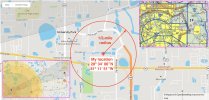I was getting ready to fly my Mavic Pro in Class G space, but before I took off I got a warning in the display that there is an Authorization Zone 300 feet away, and RTH and other functions may not operate properly if I entered it.
Has anyone entered an authorization zone inadvertently, and what's the Mavic's behavior in such a case? Does it refuse to respond to commands? Does it try to land right then and there? Are there any failsafes built in, such that it will stop before entering the Authorization Zone, taking into account its momentum while flying towards it?
The last thing that I'd want to happen is for me to lose control of the craft inside an Authorization Zone, or for it to land in an inaccessible spot.
Has anyone entered an authorization zone inadvertently, and what's the Mavic's behavior in such a case? Does it refuse to respond to commands? Does it try to land right then and there? Are there any failsafes built in, such that it will stop before entering the Authorization Zone, taking into account its momentum while flying towards it?
The last thing that I'd want to happen is for me to lose control of the craft inside an Authorization Zone, or for it to land in an inaccessible spot.





